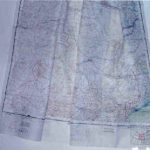WORLD WAR II – Memorabilia – Nazi Germany / USSR / United States
Rare Old & Antique Maps for Sale.
 82.00 ‘Silk Maps’, c1944 – 1952, Army Air Force / USAF
82.00 ‘Silk Maps’, c1944 – 1952, Army Air Force / USAF
Escape and Evasion Cloth Maps
Most maps today are printed on good quality paper, but there were maps produced on cloth (or, textile cartography) dating back many centuries. The fabric map technique dates from the Han dynasty. In 1973-74 excavations near Mawangdui, in the province of Ch’ang-sha, China produced three maps drawn on silk. After careful restoration, it became clear that one of these maps (now known as the Garrison Map), had been prepared by cartographers to the king of Ch’ang-sha, whose kingdom was made up of modern Hunan and that the map was for military use sometime around 168 BC. The maps we offer were first introduced by the British during World War II. The first maps during WWII were issued by M19 and based on existing maps of John Bartholomew, one of England’s most prominent map-makers. In addition to the British, the Australians and the United States began production of cloth maps. The Army Air Force (AAF) through the efforts of there Aeronautical Chart Service produced a series of the cloth maps on printed on rayon. From this came the term ‘silk maps’. One of the military uses of the silk (cloth) maps was to have them included in the survival kits of allied pilots. There durability and foldability were ideal for downed pilots in enemy territory, for escape and evasion needs [the kits were known as Escape & Evasion Survival Kits]. After WWII the cloth ‘silk maps’ continued to be used as the Cold War escalated. Soon after WW II ended, the U.S. Air Force was formed and under their Aeronautical Chart Service the cloth maps continued until the early 1950’s as part of the Cold War effort. The story of the WWII cloth (silk maps) has been difficult to piece together because of the manner in which they were developed and their production was shrouded in secrecy during and after the war. The collection we offer of these unique examples of mapping differ slightly in size. All are printed on both sides with adjoining sections. We also have a number of WW II maps listed below that are very rare and, in some case, were used by agents of the British intelligence service. The following list of cloth maps indicates ones still available: $60. each – except where noted, (shipping / handling / insurance $9.00) per order.

B-17 crew of the 398th Bomb Group, 8th Army Air Force (AAF) in England during World War II. Lt. Wallace Blackwell, co-pilot is seen standing, back row second from right.

The surrender of some 40,000 German soldiers in 1945 in Belgium.

scale 1:2,000,000; published by the USAF, Aeronautical Chart Service, Washington, D.C.; June 1950 (34.50″ x 39.20″)
Read MoreThe map is at a scale of 1:1,000,000 and was part of the Geographical Section General Staff issues.
Read Morescale 1:2,000,000; published by the USAF, Aeronautical Chart Service, Washington, D.C.; July 1950, [includes a star chart at bottom]; (29.0″ x 38.0″)
Read MorePublished at a scale of 1:1,000,000 the map was prepared by the D. Survey and printed by Balding & Mansell, Ltd.
Read Morescale 1:2,000,000; published by the USAF, Aeronautical Chart Service, Washington, D.C.; December 1950 (42.0″ x 35.50″)
Read Morescale 1:2,000,000; published by the USAF, Aeronautical Chart Service, Washington, D.C.; January 1950 (39.50″ x 39.0″)
Read Morescale 1:2,000,000; published by the USAF, Aeronautical Chart Service, Washington, D.C.; March 1951 (39.50″ x 35.0″)
Read Morescale 1:2,000,000; published by the USAF, Aeronautical Chart Service, Washington, D.C.; 1951; (38.5″ x 39.0″)
Read Morescale 1:2,000,000; published by the USAF, Aeronautical Chart Service, Washington, D.C.; February 1951 (39.0″ x 38.0″)
Read Morescale 1:2,000,000; published by USAF, Aeronautical Chart Service, Washington, D.C. May 1951 (USC&GS)
Read More